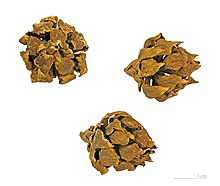Athrotaxis
| Athrotaxis Temporal range:
| |
|---|---|

| |
| Athrotaxis cupressoides | |
| Scientific classification | |
| Kingdom: | Plantae |
| Clade: | Tracheophytes |
| Clade: | Gymnospermae |
| Division: | Pinophyta |
| Class: | Pinopsida |
| Order: | Cupressales |
| Family: | Cupressaceae |
| Subfamily: | Athrotaxidoideae Quinn |
| Genus: | Athrotaxis D.Don[1] |
| Type species | |
| Athrotaxis selaginoides Don
| |
| Species | |
|
See text | |

Athrotaxisis a genus of two to three species (depending on taxonomic opinion) ofconifersin the cypress family,Cupressaceae.The genus isendemicto westernTasmania,where they grow in high-elevationtemperate rainforests.[2]
They are medium-sizedevergreentrees,reaching 10–30 m (rarely 40 m) tall and 1-1.5 m trunk diameter. Theleavesare scale-like, 3–14 mm long, are borne spirally on the shoots. Theconesare globose to oval, 1–3 cm diameter, with 15-35 scales, each scale with 3-6seeds;they are mature in 7–9 months after pollination, when they open to release the seeds. The male (pollen) cones are small, and shed their pollen in early spring.[2]
They are very susceptible tobush fires,and have declined markedly in abundance due to accidental and deliberate fires since the European colonisation of Tasmania.[2]
Classification
[edit]Taxonomy
[edit]Athrotaxisis the only living genus of the subfamily Athrotaxidoideae. A 2021 molecular study found the Athrotaxidoideae to be the sister group to theSequoioideae,which contains famously massive species such as thecoast redwood(Sequoia sempervirens) andgiant sequoia(Sequoiadendron giganteum). This is despite both subfamilies' current distributions being on entirely different hemispheres. The study indicates that both taxa diverged during the mid to lateJurassic.[3]The oldest fossil of the genus is known from the Early Cretaceous (Aptian) of Santa Cruz Province in Argentina, South America, with other fossils of the genus known from New Zealand, eastern Australia, and possibly North America. Other fossils of the subfamily are known from the Late Jurassic of Europe, as well as the Early Cretaceous of North America and China,[4]as well as possibly the Early Cretaceous of Europe, and Late Cretaceous of South America and North America.[5]
Species
[edit]| Phylogeny ofAthrotaxis[6][7] | |||||||||||||||
|
The threetaxaofAthrotaxisare variously treated as three distinct species, or as two species, with the third taxon being ahybridbetween the other two. To date, the evidence has been inconclusive, with some data suggesting hybrid origin, but other evidence suggesting the third is distinct and not a hybrid.[2]
| Image | Leaves | Scientific name | Description | Distribution |
|---|---|---|---|---|
 |
 |
Pencil Pine Athrotaxis cupressoidesD.Don. |
Leaves short, 3–5 mm, adpressed tightly on the shoots. Cones small, 1-1.5 cm, scales with a small bract only covering the centre of the scale. | Tasmania, Australia. |
 |
 |
King Billy Pine or King William Pine Athrotaxis selaginoidesD.Don. |
Leaves long, 8–14 mm, spreading out from the shoots. Cones large, 2–3 cm, scales with a large bract nearly completely covering the scale. | Tasmania, Australia. |
 |
 |
Athrotaxis laxifoliaHook. | (?A. cupressoides×A. selaginoides). Leaves short, 4–7 mm, spreading out from the shoots. Cones intermediate, 1.5-2.5 cm, scales with a medium bract covering most of the scale. | Tasmania, Australia. |
Cultivation and uses
[edit]Thewoodis scented and durable, and was extensively used in the past in Tasmania, but is now too rare for any cutting. All three make very attractiveornamental treeswith luxuriant foliage, though they are generally only planted inarboretumsorbotanical gardens.Cultivation away from their native range is successful only in areas with high rainfall, mild winters, and cool summers, such as theBritish Isles,thePacific NorthwestofNorth America,andNew Zealand.[citation needed]
Examples of the species and many of its leaf forms may be seen in the living collections atThe Tasmanian Arboretum.[citation needed]
References
[edit]- ^"Athrotaxis".Australian Plant Name Index(APNI).Centre for Plant Biodiversity Research,Australian Government.Retrieved16 March2023.
- ^abcdFarjon, A. (2005).Monograph of Cupressaceae and Sciadopitys.Royal Botanic Gardens, Kew.ISBN1-84246-068-4
- ^Stull, Gregory W.; Qu, Xiao-Jian; Parins-Fukuchi, Caroline; Yang, Ying-Ying; Yang, Jun-Bo; Yang, Zhi-Yun; Hu, Yi; Ma, Hong; Soltis, Pamela S.; Soltis, Douglas E.; Li, De-Zhu (August 2021)."Gene duplications and phylogenomic conflict underlie major pulses of phenotypic evolution in gymnosperms".Nature Plants.7(8): 1015–1025.doi:10.1038/s41477-021-00964-4.ISSN2055-0278.PMID34282286.S2CID236141481.
- ^Dong, Chong; Sun, Bai-Nian; Wu, Jing-Yu; Du, Bao-Xia; Xu, Xiao-Hui; Jin, Pei-Hong (January 2014)."Structure and affinities of Athrotaxites yumenensis sp. nov. (Cupressaceae) from the Lower Cretaceous of northwestern China".Cretaceous Research.47:25–38.Bibcode:2014CrRes..47...25D.doi:10.1016/j.cretres.2013.09.012.
- ^Andruchow-Colombo, Ana; Gandolfo, María A.; Escapa, Ignacio H.; Cúneo, Néstor R. (November 2022)."New genus of Cupressaceae from the Upper Cretaceous of Patagonia (Argentina) fills a gap in the evolution of the ovuliferous complex in the family".Journal of Systematics and Evolution.60(6): 1417–1439.doi:10.1111/jse.12842.ISSN1674-4918.
- ^Stull, Gregory W.; Qu, Xiao-Jian; Parins-Fukuchi, Caroline; Yang, Ying-Ying; Yang, Jun-Bo; Yang, Zhi-Yun; Hu, Yi; Ma, Hong; Soltis, Pamela S.; Soltis, Douglas E.; Li, De-Zhu; Smith, Stephen A.; Yi, Ting-Shuang; et al. (2021)."Gene duplications and phylogenomic conflict underlie major pulses of phenotypic evolution in gymnosperms".Nature Plants.7(8): 1015–1025.bioRxiv10.1101/2021.03.13.435279.doi:10.1038/s41477-021-00964-4.PMID34282286.S2CID232282918.
- ^Stull, Gregory W.; et al. (2021)."main.dated.supermatrix.tree.T9.tre".Figshare.doi:10.6084/m9.figshare.14547354.v1.
{{cite journal}}:Cite journal requires|journal=(help)
